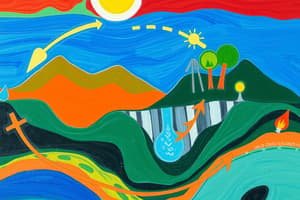Podcast
Questions and Answers
What process converts atmospheric nitrogen into ammonia?
What process converts atmospheric nitrogen into ammonia?
- Nitrogen Fixation (correct)
- Nitrification
- Denitrification
- Ammonification
What is the primary role of bacteria in the nitrogen cycle?
What is the primary role of bacteria in the nitrogen cycle?
- To circulate oxygen in the atmosphere
- To convert nitrogen into various usable forms (correct)
- To degrade organic matter
- To fix carbon from the atmosphere
Which process in the nitrogen cycle releases nitrogen back into the atmosphere?
Which process in the nitrogen cycle releases nitrogen back into the atmosphere?
- Ammonification
- Denitrification (correct)
- Nitrogen Fixation
- Nitrification
Which of the following compounds is formed during the process of nitrification?
Which of the following compounds is formed during the process of nitrification?
What is the primary human impact on the nitrogen cycle?
What is the primary human impact on the nitrogen cycle?
Which of the following best describes ammonia in the nitrogen cycle?
Which of the following best describes ammonia in the nitrogen cycle?
Which of the following is a key step that bacteria perform in the nitrogen cycle involving nitrates?
Which of the following is a key step that bacteria perform in the nitrogen cycle involving nitrates?
What happens to excess nitrates in the soil due to human activity?
What happens to excess nitrates in the soil due to human activity?
What is the process by which nitrogen is converted from the atmosphere into a usable form for plants?
What is the process by which nitrogen is converted from the atmosphere into a usable form for plants?
Which of the following processes contributes to the removal of nitrogen from the soil, converting it back to atmospheric nitrogen?
Which of the following processes contributes to the removal of nitrogen from the soil, converting it back to atmospheric nitrogen?
What process is primarily responsible for converting atmospheric nitrogen (N2) into a usable form for plants?
What process is primarily responsible for converting atmospheric nitrogen (N2) into a usable form for plants?
What form of nitrogen is primarily produced from the breakdown of organic matter in the soil?
What form of nitrogen is primarily produced from the breakdown of organic matter in the soil?
What is the primary role of denitrifying bacteria in the nitrogen cycle?
What is the primary role of denitrifying bacteria in the nitrogen cycle?
What role do bacteria play in the nitrogen cycle?
What role do bacteria play in the nitrogen cycle?
Which of the following forms of nitrogen is immediately usable by plants?
Which of the following forms of nitrogen is immediately usable by plants?
How do human activities impact the nitrogen cycle?
How do human activities impact the nitrogen cycle?
Which of the following nutrients can cause primary productivity to be limited if in short supply?
Which of the following nutrients can cause primary productivity to be limited if in short supply?
Which agents are primarily responsible for converting ammonia into nitrates in the nitrogen cycle?
Which agents are primarily responsible for converting ammonia into nitrates in the nitrogen cycle?
In what form is nitrogen primarily absorbed by plants?
In what form is nitrogen primarily absorbed by plants?
How do human activities negatively impact the nitrogen cycle?
How do human activities negatively impact the nitrogen cycle?
What is the role of primary producers in the nitrogen cycle?
What is the role of primary producers in the nitrogen cycle?
What happens to excess nitrogen that runs off from agricultural land into waterways?
What happens to excess nitrogen that runs off from agricultural land into waterways?
What happens to phosphorus in excess amounts due to human activities?
What happens to phosphorus in excess amounts due to human activities?
What is NOT a process involved in the phosphorus cycle?
What is NOT a process involved in the phosphorus cycle?
Flashcards
Nitrogen Fixation
Nitrogen Fixation
The process where bacteria convert atmospheric nitrogen gas (N2) into a usable form for plants.
Nitrogen Cycle
Nitrogen Cycle
The continuous movement of nitrogen through the environment, involving both living organisms and non-living components.
Phosphorus Cycle
Phosphorus Cycle
The continuous movement of phosphorus through the environment, involving land, ocean, sediments, and living organisms.
Primary Producers
Primary Producers
Signup and view all the flashcards
Consumers
Consumers
Signup and view all the flashcards
Fertilizer
Fertilizer
Signup and view all the flashcards
Soil Nitrogen
Soil Nitrogen
Signup and view all the flashcards
Dissolved Phosphates
Dissolved Phosphates
Signup and view all the flashcards
Carbon Reservoir
Carbon Reservoir
Signup and view all the flashcards
What is the main form of carbon in the atmosphere?
What is the main form of carbon in the atmosphere?
Signup and view all the flashcards
Where is carbon stored in the ocean?
Where is carbon stored in the ocean?
Signup and view all the flashcards
How does geological activity release CO2?
How does geological activity release CO2?
Signup and view all the flashcards
What is the role of burning fossil fuels in the carbon cycle?
What is the role of burning fossil fuels in the carbon cycle?
Signup and view all the flashcards
How does rainfall impact the carbon cycle?
How does rainfall impact the carbon cycle?
Signup and view all the flashcards
How do forests contribute to the carbon cycle?
How do forests contribute to the carbon cycle?
Signup and view all the flashcards
How does deforestation affect the carbon cycle?
How does deforestation affect the carbon cycle?
Signup and view all the flashcards
Where is Phosphorus found?
Where is Phosphorus found?
Signup and view all the flashcards
How does Phosphorus become available?
How does Phosphorus become available?
Signup and view all the flashcards
Phosphorus in the Food Web
Phosphorus in the Food Web
Signup and view all the flashcards
Ocean's Role in the Phosphorus Cycle
Ocean's Role in the Phosphorus Cycle
Signup and view all the flashcards
What is Primary Productivity?
What is Primary Productivity?
Signup and view all the flashcards
What is a Limiting Nutrient?
What is a Limiting Nutrient?
Signup and view all the flashcards
Why do farmers use fertilizer?
Why do farmers use fertilizer?
Signup and view all the flashcards
What are Micronutrients?
What are Micronutrients?
Signup and view all the flashcards
Study Notes
Recycling in the Biosphere
- Energy flows in one direction, from one trophic level to the next, eventually dissipating as heat.
- Energy from sunlight constantly enters the biosphere, but matter is recycled.
- Elements like oxygen, carbon, and hydrogen are repeatedly used in ecosystems and throughout the biosphere.
- Matter's movement involves biological, geological, and chemical processes.
- Human activity also impacts these cycles.
Cycles of Matter
- Matter is continuously transformed in these cycles, it is never created or destroyed.
- Biological processes encompass all organism activities, including eating, breathing, metabolism, and waste production.
- Geological processes involve volcanic activity, rock formation and breakdown, and earth's interior movements.
- Chemical and physical processes include cloud formation, precipitation, and the action of water and lightning.
The Water Cycle
- Water constantly moves between oceans, atmosphere, and land, sometimes inside and sometimes outside of living organisms.
- Evaporation transforms water into water vapor.
- Transport of water vapor occurs through winds.
- Condensation forms tiny droplets to create clouds.
- Precipitation falls back to Earth as rain, snow, sleet, or hail.
- Precipitation can become runoff or groundwater, eventually returning to the atmosphere via evaporation or transpiration.
- The water cycle can take up to 4000 years to complete.
The Carbon Cycle
- Carbon is found in the atmosphere as carbon dioxide, oceans, organisms, rocks, soil, and underground (as fossil fuels).
- Biological processes like photosynthesis absorb carbon dioxide, and cellular respiration releases it.
- Geological processes release CO2 through volcanic activity and the breakdown of rocks.
- CO2 dissolves in water and returns to the atmosphere.
- Burning of fossil fuels releases CO2 into the atmosphere.
The Nitrogen Cycle
- Organisms need nitrogen to build amino acids and nucleic acids.
- Nitrogen exists as a gas (N2) in the atmosphere.
- Nitrogen fixation (by bacteria) converts nitrogen gas into ammonia.
- Ammonia is converted to nitrates and nitrites by bacteria.
- Producers use these compounds to create proteins and nucleic acids.
- Decomposers release nitrogen-containing compounds, and the cycle continues.
- Human activities increase nitrogen in the biosphere through fertilizer production and use.
The Phosphorus Cycle
- Phosphorus is vital for DNA and RNA molecules.
- Phosphorus primarily exists in rocks, soil minerals, and sediments.
- Geological processes release phosphorus into the environment as it breaks down.
- Producers absorb it, and organisms reuse it.
- The cycle does not usually involve the atmosphere.
Studying That Suits You
Use AI to generate personalized quizzes and flashcards to suit your learning preferences.




